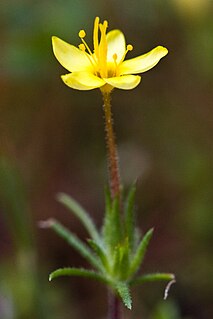
Yreka is the county seat of Siskiyou County, California, United States, near the Shasta River; the city has an area of about 10 square miles (26 km2), most of it land. As of the 2010 United States Census, the population was 7,765, reflecting an increase of 475 from the 7,290 counted in the 2000 Census. Yreka is home to the College of the Siskiyous, Klamath National Forest Interpretive Museum and the Siskiyou County Museum.

Acanthomintha duttonii is a species of annual plant endemic to San Mateo County, California in the family Lamiaceae. It is commonly called San Mateo thornmint and is found growing on serpentine soils near the Crystal Springs Reservoir in a six-mile (10 km) long strip on the east side of Montara Mountain at elevations of approximately 150 to 300 meters.

Cirsium fontinale, the fountain thistle, is a flowering perennial herb in the sunflower family. It is endemic to California. The genus Cirsium is commonly known as the "thistle" genus, Cirsium being the Greek word for 'thistle.'
Eriophyllum latilobum or San Mateo woolly sunflower is a perennial herb of sharply limited range, endemic and occurring only in the state of California, United States. This flowering plant of the family Asteraceae has been listed as an endangered species by the U.S. federal government as well as the state of California.

The Tiburon paintbrush or Tiburon Indian paintbrush is an endangered taxon of flowering plant in the family Orobanchaceae. It is endemic to the San Francisco Bay Area in California in the United States, where it occurs in Marin, Napa, and Santa Clara Counties.

Streptanthus niger is an endangered species within the family Brassicaceae. Like other genus members, this herb has wavy petal margins with perimeter calluses that discourage larval herbivory. This plant is endemic to the Tiburon Peninsula of Northern California, and occurs at elevations below 150 m on serpentine grasslands. The common name for this species is Tiburon jewelflower or black jewelflower. This annual herb blooms in May and June and displays dark purple sepals. The etymology of this genus scientific name derives from the Greek word streptanthus, meaning twisted flower, with reference to the notable wavy margins of the petals. The species name niger relates to the color of the seeds being black, although an alternate account cites the dark color of the petals as the source of the appellation.

Edward Lee Greene was an American botanist known for his numerous publications including the two-part Landmarks of Botanical History and the describing of over 4,400 species of plants in the American West.

Fritillaria gentneri, or Gentner's fritillary, is a rare species of flowering plant in the lily family Liliaceae, that is endemic to southwest Oregon and adjacent Siskiyou County, California, USA. Its habitat is dry, open woodlands and chaparral at 1,000–5,000 ft (300–1,520 m), where it blooms from March through July. However, most populations have generally finished blooming by the end of May. As with many plants, the lower elevations bloom earliest with the bloom period moving up following elevation.

Eriogonum alpinum is a species of wild buckwheat known by the common name Trinity buckwheat.

The Boggs Lake Ecological Reserve is a nature reserve in Lake County, California. The land area is about one quarter of a square mile and contains a large vernal pool as well as endangered plants such as the Boggs Lake hedge-hyssop.
Arnica spathulata is a rare North American species of arnica in the sunflower family, known by the common name Klamath arnica. It is native to the Klamath Mountains of northwestern California and southwestern Oregon. It grows in woodland habitat, almost exclusively on serpentine soils.

Erigeron petrophilus is a species of flowering plant in the daisy family known by the common names rockloving erigeron or cliff fleabane. It is native to the mountain ranges of California from Siskiyou County south as far as San Luis Obispo County and El Dorado County. It also grows in southwestern Oregon.

Leptosiphon acicularis is a species of flowering plant in the phlox family known by the common names bristly linanthus and bristly leptosiphon.

Leptosiphon grandiflorus is a species of flowering plant in the phlox family known by the common names large-flower linanthus and large flowered leptosiphon.

Leptosiphon nuttallii is a species of flowering plant in the phlox family known by the common name Nuttall's linanthus.

Acmispon dendroideus, synonym Syrmatium veatchii, is a species of legume native to California. It is known by the common name island broom. It is endemic to the Channel Islands of California, where it grows on coastal bluffs and cliffs. It is a spreading perennial herb or erect shrub approaching 2 meters in height. It is hairless to hairy and gray-green in color. The branches lined with leaves each made up of a few oval leaflike leaflets up to 1.5 centimeters long each. The inflorescence bears up to 10 yellow pealike flowers, each roughly a centimeter long and fading red as they age.
Navarretia rosulata is a rare species of flowering plant in the phlox family known by the common names San Anselmo navarretia, Marin County navarretia, and Marin County pincushionplant.
Navarretia setiloba is a rare species of flowering plant in the phlox family known by the common names Paiute Mountain pincushionplant and Piute Mountains navarretia.

Silene campanulata is a species of flowering plant in the family Caryophyllaceae known by the common names Red Mountain catchfly and bell catchfly. It may be a synonym of Silene greenei.

Lespedeza leptostachya is a rare species of flowering plant in the legume family known by the common names prairie lespedeza and prairie bush-clover. It occurs in the Upper Midwest region of the United States. The flowers are creamy-white to purplish and arranged into a narrow terminal spikes.
















